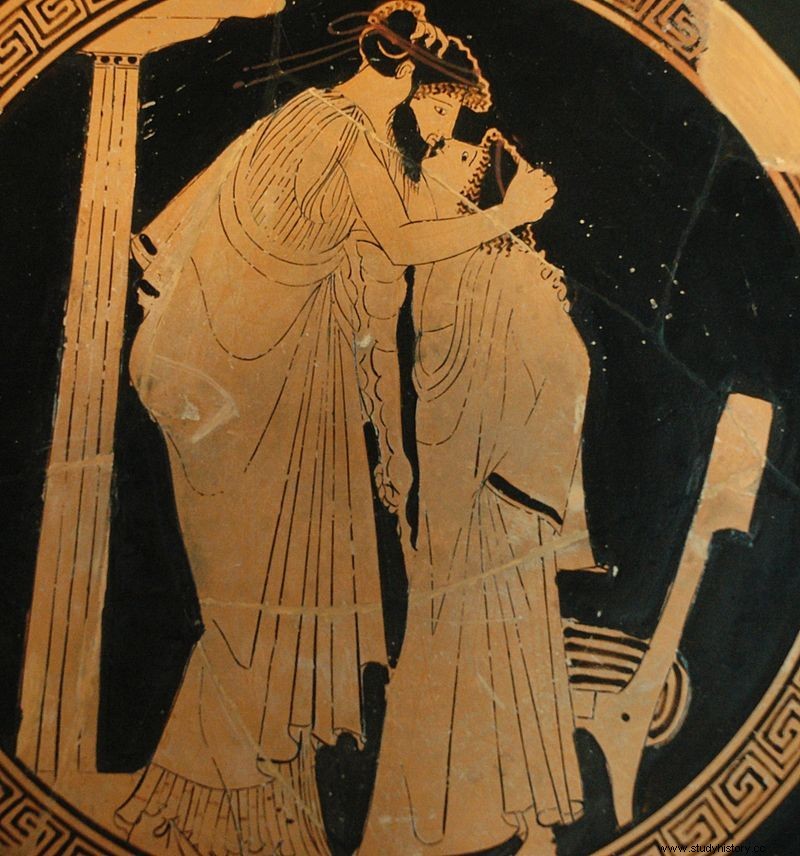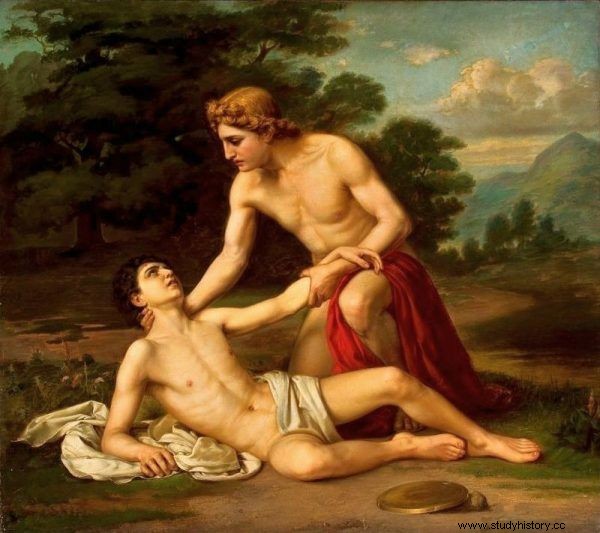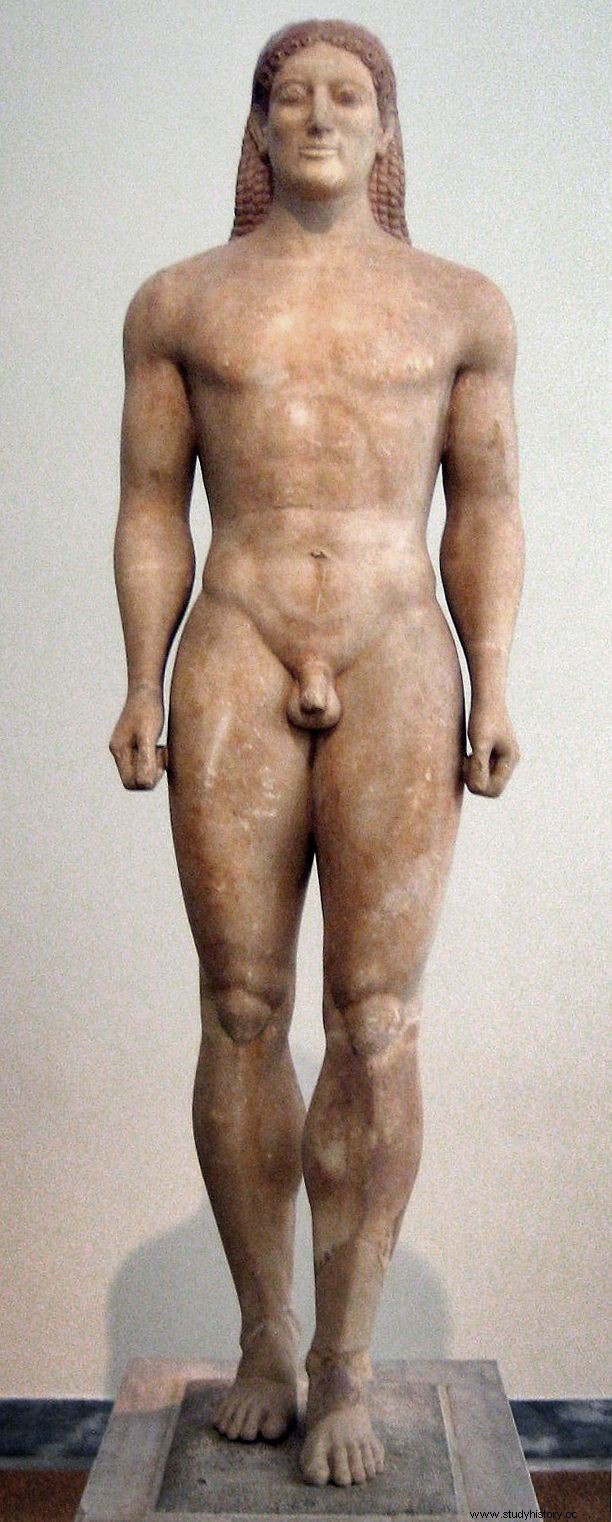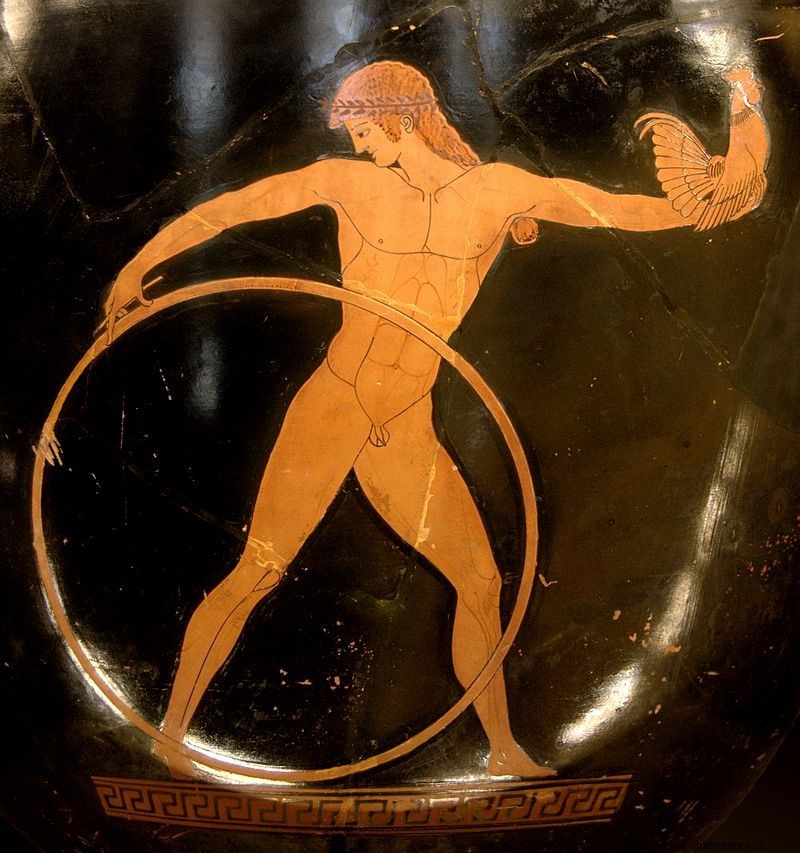At a time when women were treated as inferior beings, the relationship between older men and young lovers was considered the only admirable love. But are love and erotic fascination the same?
"Whoever loves no one, will never know anyone's love" - warned those living at the turn of the 5th and 4th centuries BCE. the thinker Democritus of Abdera. But who to love and how? What is real feeling? How to recognize them? According to Aristophanes, one of the heroes of Plato's "Feast" (written around 385-370 BCE), there used to be no two sexes among people, but three:male, female and zwitterion. In addition, our ancestors had two heads, four arms and four legs. One day, however, Zeus cut these strange creatures in two.
“So each of us is like a whole ticket coupon, because each one was created, like a stingray fish, together with someone else from some former, one creature. Therefore, each of us always looks for his coupon "- said the Greek comedy writer. He explained why some people prefer the company of the opposite sex (they are from the pre-human hermaphrodite), and others of the same (primitive male or female).
On the surface, this sounds tolerant and democratic. In fact, the only true love in ancient Greece was the feeling of mature men towards adolescent boys . However, it was not so much about sexual contacts as, above all, an intellectual and spiritual bond between the partners, which would result in a lifelong friendship. According to supporters of pederasty, it was, next to philosophy, one of the greatest inventions of mankind!
Better than women
The philosopher Diotyma in Plato's Banquet explained that the desire to commemorate oneself pushes some men towards women and giving birth to children, while others towards love for boys and impregnating their souls. According to the poet Meleagra from the 2nd-1st centuries BCE, just as Aphrodite ignited carnal lust for women, so Eros ignited love for boys. The male idol was the personification of love, and not the mere amusements for which the goddess was responsible.

In ancient Greece, boys became the subject of interest of adult men as early as around the age of 12. The illustration "Kiss" of the painter Bryzeis from around 480 BC.
"The real Eros has nothing to do with the female chambers, not a blade of grass!" - assured one of the heroes of the "Dialogue on erotic love" Plutarch of Cheronea at the beginning of the 2nd century CE He pointed to the strength of the noble bond between eromenos (bridegroom) and erastesem (lover) as opposed to the desire that connects a man to a woman, "like a dog ... to a female".
However, pederasty was not about a love completely free from sensuality, as evidenced by heroes both mythical (Achilles recalling Patroclus's thighs with tears) and historical (lawmaker Solon sighing at the loins and lips of boys). Except that the sexual contacts that took place seemed - at least theoretically - to play a secondary role.
They put on restraint. The older partner ( erastes or "lover") was the mentor of the younger ( eromenos or "bridegroom"). He was supposed to give him lessons in civic education. To encourage ambitious and great deeds, such as, for example, the actions of tyranicides. Instill the ideals of kalokagatii - the beauty and the good that the Greeks believe should lead a virtuous life. At the same time, he gave the young man affection, was fascinated by him, cherished him, admired his body and used it . The boy was rewarding him with admiration but by no means erotic fascination . It was a matter of social convention, not sexual preference.

This article was written during the author's work on the book "Ages of shamelessness. Sex and erotica in antiquity ”(CiekawostkiHistoryczne.pl 2018). Buy with a discount on empik.com.
When we look at the sculptures depicting the tyranticides of Athens, we see that one of them has a beard and is clearly more mature than the other. The older one is Aristogejton, who competed for the beautiful, even-faced Harmodios, with the tyrant Hipparchus. It was Aristogejton who was to watch over the spiritual development of his beloved and over the choices he made. And Harmodios had to be careful not to show his partner too much affection and not lose his temper. It could have spoiled his opinion (you can read more about the famous tyrannocides HERE).
In Doric Crete
Tyrant killers became the role model, but of course they were not where the Greek pederasty began. According to the Greeks, its inventor was the mythical king of Thebes Laius, the father of Oedipus. Among the gods, homosexual episodes have happened to Zeus and Apollo.
According to historians, pederasty in the Greek world could have been born as early as 1600-1900 BC. It spread for good in the days after Homer (hence the disputes over the relationship between Achilles and Patroclus in "The Iliad"), and around the 6th century BCE. has become popular. It is connected with the spread of Doric tribes in Greece, pushing the Ions to the east. It was in Doric Crete that it became an almost adolescent rite of passage.
According to the Greek historian Eforos of Kyme, quoted four centuries later by Strabo, it was as follows. A boy growing up, chosen by a man in love with him, was kidnapped by this lover with the permission of his and his friends. He hunted and feasted with him and his friends for two months, after which he gained the rights of adult men. Interestingly, even confided in his friends if he enjoyed intimate intercourse with his lover (what a few hundred years later in Athens would be shocking).

Homosexual relationships happened not only to humans, but also to Greek gods. According to mythology, the beloved of the god Apollo was the beautiful young man Hyacinth, murdered out of jealousy by another god, Zephyr. Image by Alexander Kiselev.
It is also from Crete that the earliest depiction of a man's courtship towards a young man - on a bronze plate from the 7th century BCE. In turn, on the nearby island of Thera, inscriptions from the 7th-6th centuries BCE were found in the ruins of a gymnasium, in which men (boys?) Boasted about their relations with others, maybe even in a group.
Plutarch, on the other hand, mentioned a significant event from the Lelantian War, which took place around 700 BCE. between Chalcis and Eretria. A man named Kleomach, a native of Thessaly, was to lead a Chalcidian infantry attack on enemy cavalry. Before the attack, he asked his beloved if he would watch the fight. The boy said yes, embraced the warrior and put on his helmet. The encouraged Kleomach led a daring attack on his enemies in front of his lover. Unfortunately, he himself died in battle. The grateful Chalkidim erected a magnificent tomb for the war hero. They also began to appreciate the previously condemned pederasty.
Hares and cockerels
The men were interested in boys aged twelve to eighteen, when they were reaching the so-called age of epheba . The closer to this border, the more attractive and inaccessible the teenager seemed. Almost seven centuries after Harmodios and Aristogejton, the poet raved about:
When a boy is twelve, I am happy
And when he enters his thirteenth year, it attracts me even more,
But at fourteen he is sweeter, he is a flower of love,
Fifteen beginners make love more delightful.
Sixteen-year-olds are meant for gods to all,
And I'm not looking for seventeen; belong to Zeus,
When even older ones tease you, the game stops,
You wait for him to say yes to you .

So the ancients imagined the ideal young man. Unfortunately, with the appearance of facial hair, it was losing its attractiveness.
With the appearance of facial hair, the teenager lost his beauty and attractiveness:
A hair is already covering your calves, my dear Nikandros.
Know that it will soon cover your face as well,
And not as generous as you'll find
Your suitors will be here.
Because youth doesn't last forever - keep that in mind .
Eromenos (The "bridegroom") has always been a subordinate party in the relationship and sexually passive towards erastes ("The lover"). But at the same time this teenager, if he had already grown up from adolescence, could himself become an older partner in relation to a boy just entering adolescence. He would therefore be erastes at the same time and eromenos for different partners - nobody was bothered by it .
Gifts for charges
Do we know how the men were introduced to and what the pick-up was like? We have to take into account that virtually any adult Athenian could be erastes . Given the goals of pederasty, many free non-citizens, i.e. The metaques had little to offer because of their status - and yet they could try to love the boys. Only slaves were forbidden to do so. By contrast, the number of boys aged 12-18 was quite limited.
Certainly some of them stood out, others seemed less attractive - quite like the virgins on the issue. The elders watched them in the streets and during exercises, when they showed off their fitness (not in a gymnasium, because pickup there was forbidden by Athenian law). Fitness was important not because of the sexual abilities of the young men - more important because they were to do military service in the future, fight and win for their city.
Erastes he was trying to win the favor of the boy who had caught his attention. What? With his own behavior, well-groomed appearance (an aging man could be simply repulsive to young boys), wisdom, social standing, and even singing at the door of his beloved's house. And gifts . Sometimes they were modest, symbolic, such as twigs and wreaths. Another time, practical, useful for gymnasium exercises - sports equipment (balls, hoops) and containers for body oil. Sometimes erastesi they handed out "educational" gifts such as musical instruments (such as lyres) or writing boards. Another time, helmets - in reference to the military duties of the citizens of Athens.
However, gifts in the form of animals have become the most popular. Most often (as can be seen in ancient ceramics) hares and roosters were chosen. However, there were also deer, wild birds, hunting dogs and even cheetahs! They weren't meant to be pets or live toys. It was about the "pedagogical" aspect:they were useful for hunting, racing or other sports competitions. They were also associated with virility and masculinity (especially hares and roosters).
The historic paintings show that the competition for boys aroused great emotions. Let's take a red-figure Attic vase from around 500-490 BC that shows this symbolically. We see Ganymede, the mythical young Trojan prince, famous for his beauty, who charmed the god Zeus himself.

Ganymede, beloved god Zeus, holding gifts from his divine (and older!) Lover. Painting on a Greek vase.
The ruler of Olympus abducted him to spend a hectic time with him. On the vase we can see that the beautiful man from Troy has a wreath on his head, he holds a hula hoop in one hand and a cockerel in the other. This bird is a typical gift from eromenos from erastes in this case, Ganymede probably got it from Zeus. We see the god of the gods on the other side of the vase, with a scepter. But why is he running? One may wonder if there is a second bottom to history. Because if Zeus gave Ganymede a cockerel, from whom did the prince get a wreath and a hoop? Could Zeus have a competitor and it was he who was going to impose the punishment?
The gifts were also a form of thanks to eromenos for the considerations and experiences they provided. No wonder, after all, they did not feel pleasure during intercourse with erastes . So they deserved to be appreciated. Of course, this was not in the form of a reward, but a noble and pedagogical form of gratitude. At least that was the assumption. The reality could have been different - especially during feasts, when the brakes were released on more than one occasion. This, in turn, could have been the source of a scandal that tarnished many Athenians ...
***
The text was created during the author's work on his latest book. " Ages of shame. Sex and erotica in antiquity ” . Click and buy with a discount on empik.com.
Bibliography:
- Robert H. Allen, The Classical Origins of Modern Homophobia , McFarland 2006.
- Alcaeus, Epigram XII, 30, Palatine Anthology , in:Carola Reinsberg, The Sexual Mores of the Ancient Greeks , crowd. Bożena Wierzbicka, Uraeus Publishing House, 1998.
- Louis Crompton, Homosexuality and Civilization , Harvard University Press, 2003.
- Keneth J. Dover, Greek Homosexuality , crowd. Janusz Margański, Homini Publishing House 2004.
- Paweł Fijałkowski, Sexuality, psyche, culture. Homoeroticism in the ancient world , Wydawnictwo Psychologii i Kultury Eneteia, 2007.
- Nina Gładiuk, Omphalos, the navel of the world , Institute of Political Studies of the Polish Academy of Sciences, 1997.
- Hellas and Roma , crowd. Irena Krońska, Common Knowledge, 1958.
- Jennifer Larson, Greek and Roman Sexualities:A Sourcebook , Bloomsbury, 2012.
- Rafał Matuszewski, Why did the Greeks love boys? , in:Focus Historia Ekstra, No. 3/2013.
- Robin Osborne, Virginia Stroud-Lewis, Esterson Lackersteeen, Archaic and Classical Greek , Oxford University Press, 1998.
- Plato, Feast , in:Platon, Dialogues , crowd. Władysław Witwicki, State Scientific Publishers, 1958.
- Plutarch, Dialogue on erotic love , in:Plutarch, Moralia (choice) , crowd. Zofia Abramowiczówna, State Scientific Publishers 1977.
- Straton, Epigram XII, 4, Palatine Anthology , in:Carola Reinsberg, The Sexual Mores of the Ancient Greeks , crowd. Bożena Wierzbicka, Uraeus Publishing House, 1998.
- John G. Younger, Sex in the Ancient World from A to Z , Routledge, 2005.
